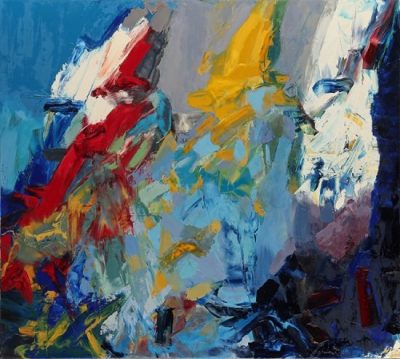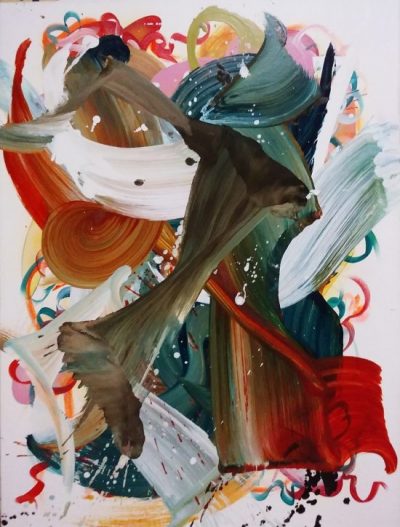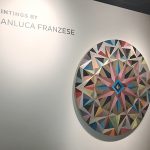John DiPaolo: Four Decades of Painting
Jerry Carniglia: A Tribute
May 11 through August 13, 2017
ABOUT THE ARTISTS
John DiPaolo: Four Decades of Painting

John DiPaolo, Inca, 2016, Oil on canvas
John DiPaolo’s abstract paintings roil with an inexhaustible energy. Underpinned by a shape-shifting kaleidoscopic dynamism, they offer up configurations of form, color and movement that crystalize and tremble before sinking swiftly back into the composition. And while the paintings draw much of their vitality from this perpetual imminence, the unwavering soundness with which the DiPaolo knits these cycles of formation and re-formation imparts the work with a sense of solidity and monumentality. As objects harboring equal parts spirit and strength they have the power to both profoundly move and fortify those who approach with unfettered eyes. Such visceral effects are not incidental but rather directly precipitated by DiPaolo’s remarkable understanding of what painting is what painting is meant to achieve. It is therefore unsurprising to learn that, for the last 40 years, John DiPaolo has pushed the limits of abstraction to make art that “says and does something,” rather than art that caters to the styles most common presuppositions.
DiPaolo strives to make paintings that speak to people. Though his works are non-objective and non-representational he nevertheless wants his viewers “to relate to them something from nature.” By this he means he wants viewers to bring their memories of particular places, people, and emotions to the experience of his paintings. To move the viewer, a painting has to enter a dialectic of formation, interpretation, and re-formation between itself, the audience, and the outside world. The result is often surprising. Many viewers, for example, identify the semblance of figures and faces, both human and not, in his paintings. Asked if he minded such observations DiPaolo answers by paraphrasing Robert Rauschenberg, “Whatever you see in my paintings, I put there.” For DiPaolo, who aspires to capture something about the human experience, figurative interpretations are evidence that a painting has struck a meaningful cord for the viewer. Rather than pursuing a superficial relationship predicated on conservative understandings of spectatorship, he deploys form, color, and texture with the hope of drawing viewers in, not holding them at a distance.
Throughout the course of his artistic career, John DiPaolo has endeavored to make art that acts as a prism through which we can reflect upon our own lives. The thoughtful intensity with which he executes his gestures, layers forms, and orchestrates color relations produces an immersive effect that reverberates throughout the body and awakens an upsurge of memories and emotions. Though DiPaolo has certainly been influenced by other artists and art world discourses—it would be impossible for any artist to claim otherwise—he has never fallen trap to the critical whirlpools or powerful undertows of popular trends. For him, remaining true to painting means remaining true to himself and to his participation in an altogether different current, one that unites the human, nonhuman, and numinous alike.
—Excerpted from “Toward A New Abstraction,” John DiPaolo: A Forty-Year Retrospective, by Frances Malcolm
John DiPaolo was born in Brooklyn, New York in 1946. He earned a B.F.A. from San Francisco Art Institute in 1974 followed by a M.A. from San Francisco State University in 1977. In addition to exhibiting across the United States, DiPaolo’s works can be found in renowned private and public collections such as the Achenbach Collection, Fine Arts Museums of San Francisco; the San Jose Museum of Art, San Jose, CA; and the Crocker Museum of Art, Sacramento, CA.
Jerry Carniglia: A Tribute

Jerry Carniglia, Recast, Entropy series, 2009, Oil on canvas
Co-sponsored by the Western Regional Chapter of the Italian American Studies Association
At a time when ideas stripped of material form have become a normative mode of art making, Jerry Carniglia gives us bold abstract paintings that argue for the validity of actual, lived experience. His art fuses deep physical engagement with the belief that nature can be used as a metaphor to describe our desire to transform the reality we inherit into an idealized world – one we might actually create and inhabit if we had the power. His impulse, initially inspired by European Expressionism, is essentially romantic, and the results are paintings that are, if nothing else, emotive.
A native of San Francisco, Carniglia, after military service in Vietnam and two years spent traveling in Africa, earned a B.A. in English literature and drama from U. C. Berkeley in 1975. He then performed with San Francisco’s celebrated Eureka Theater Company and designed sets for the avant-garde dance company, MAFISHCO. In 1985, inspired by wood-craft skills learned from his father, he created a line of custom-designed furniture which was shown in gallery exhibitions. That led him to painting. In 1993 he earned an M.F.A., also at Berkeley, which turned loose and refocused passions that had been previously simmering below the surface.
“Entropy” refers to the second law of thermodynamics which states that order runs to chaos. While Carniglia’s [Entropy Series] paintings teem with chaotic activity, there is nothing apocalyptic or ironic about them. These resplendent, vivacious canvases are rendered in bright colors and in a thick medium with sweeping, exuberant arm-length gestures. They describe, in retina-tingling hues and swirling, raked lines, the power of crashing and colliding waves and the relentless energy of jungle foliage, proliferating in scythe-shaped fronds. Avoiding illusionism, he defines space by painting these shapes in contrasting colors, often in jarring mash-ups. As such, these works are actually counter-entropic because they pull order out of chaos. But they are not what you’d call orderly.
In the studio, Carniglia refers frequently to “an order that overwhelms the intended order” and “the potential for disorder to become a higher order.” “Paint,” he explains “never goes where I want it to go – that is, if I want to keep it alive.”
—David M. Roth, 2010
David M. Roth is the editor and publisher of Squarecylinder, the online visual art magazine for Northern California.
Jerry Carniglia passed away on June 7, 2015. His works can be found in many prestigious private collections as well as in the collections of the Fine Arts Museums of San Francisco, San Francisco, CA, and the Berkeley Art Museum, Berkeley, CA.






